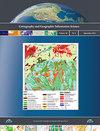Virtual reality for geospatial education: immersive technologies enhance sense of embodiment
IF 2.4
3区 地球科学
Q1 GEOGRAPHY
Cartography and Geographic Information Science
Pub Date : 2022-11-14
DOI:10.1080/15230406.2022.2122569
引用次数: 2
Abstract
ABSTRACT This article focuses on the role of embodiment in learning spatial phenomena in virtual reality in the context of geospatial education. We conducted an empirical study on the geovisualization of global earthquake locations in immersive VR and desktop VR. We asked students to visualize cross-sections of the geometry of earthquake locations in subduction zones and answer pre- and post-experience questions. The degree of the sense of embodiment in immersive VR versus desktop VR was researched. We defined the sense of embodiment based on two embodied affordances: (1) embodied relative reference frame and (2) bodily engagement. We found that immersive VR has a significantly higher sense of embodiment than desktop VR. Additionally, students showed a significantly higher level of reflective thinking in immersive VR. In terms of learning performance, students significantly gained knowledge in both conditions when comparing their pre- and post-knowledge. However, we could not find any significant difference between immersive and desktop VR. The lower level of embodiment in desktop VR seemed sufficient to improve students’ grades. These results encourage more research studies on the effect of the sense of embodiment on learning in the geospatial and earth sciences.地理空间教育的虚拟现实:沉浸式技术增强了体现感
摘要本文着重探讨在地理空间教育背景下,化身在虚拟现实中学习空间现象中的作用。我们在沉浸式VR和桌面VR中对全球地震位置的地理可视化进行了实证研究。我们要求学生将俯冲带地震位置的几何截面可视化,并回答体验前和体验后的问题。研究了沉浸式虚拟现实与桌面式虚拟现实的具体化程度。我们基于两种具体的可供性来定义具体感:(1)具体的相对参照系和(2)身体参与。我们发现,沉浸式VR比台式VR具有更高的体现感。此外,学生在沉浸式虚拟现实中表现出明显更高水平的反思思维。在学习表现方面,当比较他们的前知识和后知识时,学生在这两种情况下都显著地获得了知识。然而,我们没有发现沉浸式VR和桌面VR之间有任何显著的区别。桌面VR中较低水平的体现似乎足以提高学生的成绩。这些结果鼓励更多关于化身感对地理空间和地球科学学习影响的研究。
本文章由计算机程序翻译,如有差异,请以英文原文为准。
求助全文
约1分钟内获得全文
求助全文
来源期刊
CiteScore
5.20
自引率
20.00%
发文量
23
期刊介绍:
Cartography and Geographic Information Science (CaGIS) is the official publication of the Cartography and Geographic Information Society (CaGIS), a member organization of the American Congress on Surveying and Mapping (ACSM). The Cartography and Geographic Information Society supports research, education, and practices that improve the understanding, creation, analysis, and use of maps and geographic information. The society serves as a forum for the exchange of original concepts, techniques, approaches, and experiences by those who design, implement, and use geospatial technologies through the publication of authoritative articles and international papers.

 求助内容:
求助内容: 应助结果提醒方式:
应助结果提醒方式:


